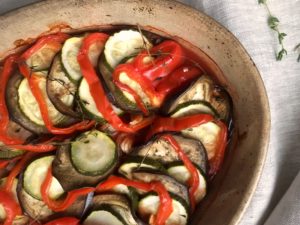 Here is one last Provençal dish—albeit one I have been cooking for years and years, long before spending the summer in Provence. But spending time in Aix-en-Provence really brought home why this dish is such a classic from this sun-drenched region.
Here is one last Provençal dish—albeit one I have been cooking for years and years, long before spending the summer in Provence. But spending time in Aix-en-Provence really brought home why this dish is such a classic from this sun-drenched region.
 For one, it uses all of the produce that is piling ever higher at the daily fruit and vegetable markets by the end of summer: eggplant, red peppers, tomatoes, and zucchini.
For one, it uses all of the produce that is piling ever higher at the daily fruit and vegetable markets by the end of summer: eggplant, red peppers, tomatoes, and zucchini.
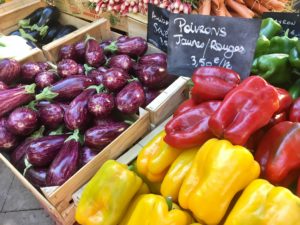 But more than that, it’s the way those vegetables combine to make something that is at once simple and yet so deeply flavored that feels typical of Provence.
But more than that, it’s the way those vegetables combine to make something that is at once simple and yet so deeply flavored that feels typical of Provence.
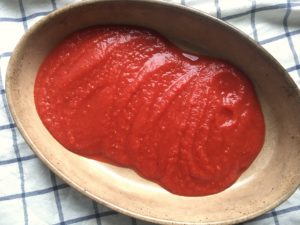
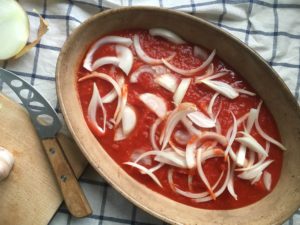
Finally, ratatouille is so versatile—something that I think we can all appreciate in the summer, when beautiful weather encourages you to throw previous dinner plans to the wind. Yes, you could serve ratatouille alongside a beautiful piece of fish for a family dinner, but you could also enjoy it simply on top of toasted baguette for lunch, or atop a bed of grain, topped with goat cheese, for dinner solo. It’s as good room temperature as it is warm, and it is certainly better the day after it is cooked.
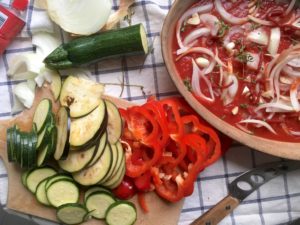

Like the salade niçoise, there is considerable debate over what constitutes a traditional ratatouille. Suffice to say that a Provençal grandmother would likely not approve of this take. Typically, one would cook each vegetable individually, then simmer them all together; here, they are simply sliced thinly, layered, and then baked in the oven. It may not be traditional, but it’s dead simple, and by the second day, the flavors of all the different vegetables still meld beautifully.
Other recipes from a summer in France:
Salade Niçoise
Goat Cheese Toasts with Herbed Cherry Tomato Compote
Plum Clafoutis
Ratatouille
Serves 6 as a side
Adapted from Smitten Kitchen
Ingredients
1/2 onion, diced or very thinly sliced
3 garlic cloves, thinly sliced
About 1 cup of tomato puree (Can’t find tomato puree? Canned diced or crushed tomatoes work fine, too.)
1 tablespoon tomato paste
2 tablespoons olive oil, divided
1 eggplant, as long and thin as you can find (Japanese eggplant are great here, but you can use whatever!)
2 zucchini (green or yellow or both, just look for ones that are of relatively uniform width, all the way down)
2 longish or 3 shortish red bell peppers
Few sprigs fresh thyme
Salt and pepper
Instructions
Preheat oven to 375F (190C).
Pour tomato puree or diced tomatoes into bottom of an oval baking dish, approximately 10 inches (25 cm) across the long way. Mix through the tomato paste, sliced garlic, onions, and olive oil. Season with salt and pepper. Throw a few thyme leaves or whole sprigs (if the stalks aren’t too woody) on top.
Trim the ends off the eggplant, zucchini and yellow squash. As carefully as you can, trim the stem end off the red pepper and remove the core, leaving the edges intact. You’re trying to make circles of red pepper, but don’t fret if it doesn’t go perfectly—this is a very rustic dish!
On a mandolin or with a very sharp knife, cut the eggplant, zucchini, and red peppers into very thin slices, approximately 1/16-inch thick. Can’t get them that thin? Again, don’t worry—just go for quite thin and relatively uniform. (Of course, the thicker the pieces get, the longer the baking time.)
Atop the tomato sauce, arrange slices of prepared vegetables concentrically from the outer edge to the inside of the baking dish, overlapping so just a smidgen of each flat surface is visible, alternating vegetables. Sometimes, if my eggplant is wider than my zucchini, I layer two slices of zuke side-by-side on top of each slice of eggplant. You may have a handful of veg leftover that do not fit.
Drizzle the remaining tablespoon olive oil over the vegetables and season them generously with salt and pepper. Remove the leaves from the thyme sprigs with your fingertips, running them down the stem. Sprinkle the fresh thyme over the dish. I also like to lay a few sprigs on top that are still on the stem, because they look pretty.
Cover dish with a piece of parchment paper cut to fit just inside the gratin dish.
Bake for approximately 45 to 55 minutes, until vegetables have released their liquid and are clearly cooked, but aren’t totally limp. They should not be brown at the edges, and you should see that the tomato sauce is bubbling up around them. If you sliced your veg a bit thicker, this will take a bit longer. If you are feeling impatient, you could turn the heat up to 400F (204C).
When finished, remove from oven to cool slightly before serving. Or: serve at room temperature or reheated the next day! It is much better after sitting, even just overnight.
Serving suggestions: alongside fish, a green salad, baguette, and cheese; atop couscous or farro topped with goat cheese; on big hunks of toasted baguette for a meal, or little slices for a little starter; on toast with eggs for brekky; inside a crepe or omelette for any meal… the options are endless!
Notes
Because of the varying lengths of vegetables, the quantities of ingredients are necessarily a bit imprecise. When I’m at the market (or grocery store, back in the States), I usually eyeball things, trying to pick out equivalent lengths of eggplant, zucchini, and bell peppers. If you have a bit of something left over, you can bake it off on a baking paper-lined tray (eggplant), sauté it for an omelette or a side (zukes and peppers), or munch on them raw (peppers).
Leave a Reply